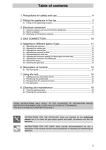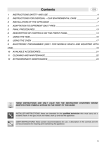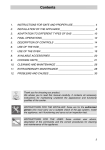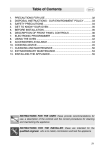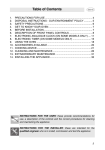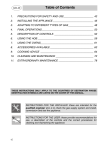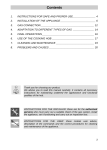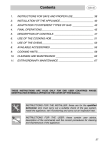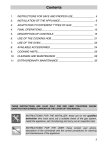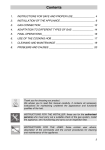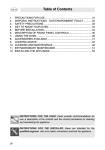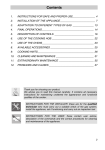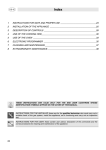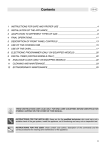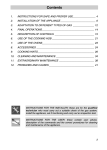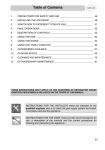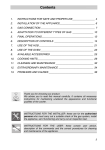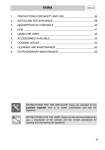Download installation and operating instructions
Transcript
smeg ��� ��� technology with style installation and operating instructions A31X freestanding cooker Table of Contents 1. PRECAUTIONS FOR SAFETY AND USE ____________________________ 4 2. INSTALLING THE APPLIANCE ____________________________________ 6 3. ADAPTATION TO DIFFERENT TYPES OF GAS______________________ 12 4. FINAL OPERATIONS ___________________________________________ 14 5. DESCRIPTION OF CONTROLS___________________________________ 15 6. USING THE HOB ______________________________________________ 22 7. USING THE OVENS ____________________________________________ 24 8. ACCESSORIES AVAILABLE _____________________________________ 25 9. COOKING ADVICE _____________________________________________ 27 10. CLEANING AND MAINTENANCE _________________________________ 35 11. EXTRAORDINARY MAINTENANCE _______________________________ 40 Thank you for choosing our product. We advise you to read this manual carefully. It contains all necessary instructions for maintaining unaltered the appearance and functional qualities of the cooker. INSTRUCTIONS FOR THE INSTALLER: these are intended for the authorized person who is to check the gas supply system and install, commission and test the appliance. INSTRUCTIONS FOR THE USER: these provide recommendations for use, a description of the controls and the correct procedures for cleaning and maintaining the appliance. 3 Presentation 1. PRECAUTIONS FOR SAFETY AND USE THIS MANUAL IS AN INTEGRAL PART OF THE APPLIANCE. TAKE GOOD CARE OF IT AND KEEP IT TO HAND THROUGHOUT THE COOKER'S LIFE CYCLE. USERS ARE ADVISED TO READ THIS MANUAL AND ALL THE INSTRUCTIONS IT CONTAINS BEFORE USING THE COOKER. ALSO KEEP THE SET OF NOZZLES PROVIDED IN A SAFE PLACE. INSTALLATION MUST BE CARRIED OUT BY QUALIFIED STAFF IN COMPLIANCE WITH THE RELEVANT REGULATIONS. THIS APPLIANCE IS INTENDED FOR HOUSEHOLD USE AND COMPLIES WITH THE EEC DIRECTIVES CURRENTLY IN FORCE. THE APPLIANCE IS BUILT TO PROVIDE THE FOLLOWING FUNCTION: COOKING AND HEATING FOODS; ALL OTHER USES ARE TO BE CONSIDERED IMPROPER. THE MANUFACTURER DECLINES ALL LIABILITY FOR USES OTHER THAN THOSE STATED ABOVE. NEVER LEAVE PACKAGING RESIDUES UNATTENDED IN THE HOME. SEPARATE WASTE PACKAGING MATERIALS BY TYPE AND CONSIGN THEM TO THE NEAREST SEPARATE DISPOSAL CENTRE. THE APPLIANCE MUST BE CONNECTED TO EARTH IN COMPLIANCE WITH ELECTRICAL SYSTEM SAFETY REGULATIONS. THE PLUG TO BE CONNECTED TO THE POWER SUPPLY LEAD AND THE RELATIVE SOCKET MUST BE OF THE SAME TYPE AND COMPLY WITH THE RELEVANT REGULATIONS. THE POWER SUPPLY SOCKET MUST BE ACCESSIBLE EVEN AFTER THE APPLIANCE HAS BEEN BUILT-IN. NEVER DISCONNECT THE PLUG BY PULLING ON THE POWER SUPPLY LEAD. IMMEDIATELY AFTER INSTALLATION, CARRY OUT A QUICK TEST ON THE APPLIANCE FOLLOWING THE INSTRUCTIONS PROVIDED LATER IN THIS MANUAL. IF THE APPLIANCE FAILS TO OPERATE, DISCONNECT IT FROM THE ELECTRICAL MAINS AND CONTACT YOUR NEAREST SERVICE CENTRE. NEVER ATTEMPT TO REPAIR THE APPLIANCE YOURSELF. AFTER EACH USE OF THE APPLIACE, ALWAYS CHECK THAT THE CONTROL KNOBS ARE TURNED TO (OFF). NEVER PLACE FLAMMABLE OBJECTS IN THE OVENS: IF THEY SHOULD ACCIDENTALLY BE SWITCHED ON, THIS MIGHT CAUSE A FIRE. THE NAMEPLATE WITH THE TECHNICAL DATA, SERIAL NUMBER AND MARK IS IN A VISIBLE POSITION IN THE STORAGE COMPARTMENT. THE NAMEPLATE MUST NEVER BE REMOVED. 4 Presentation NEVER PLACE PANS WITH BOTTOMS WHICH ARE NOT PERFECTLY FLAT AND SMOOTH ON THE HOB PAN STANDS. THE APPLIANCE BECOMES VERY HOT DURING USE. TAKE CARE NOT TO TOUCH THE HEATING ELEMENTS INSIDE THE OVEN. THIS APPLIANCE MUST NEVER BE INSTALLED ON A STAND. INSTALL THE APPLIANCE SO THAT WHEN DRAWERS OR DOORS OF UNITS INSTALLED AT HOB HEIGHT ARE OPENED, ACCIDENTAL CONTACT WITH PANS ON THE HOB IS NOT POSSIBLE. NEVER USE PANS OR GRIDDLE PLATES WHICH PROJECT BEYOND THE OUTSIDE EDGE OF THE HOB. THE APPLIANCE IS INTENDED FOR USE BY ADULTS. KEEP CHILDREN AT A SAFE DISTANCE AND NEVER ALLOW THEM TO PLAY WITH IT. REPLACED APPLIANCES MUST BE TAKEN TO A SPECIAL GARBAGE COLLECTION CENTRE. THIS APPLIANCE IS DESIGNED FOR COOKING FOOD AND IT SHALL NOT BE USED AS A SPACE HEATER. WHERE THIS APPLIANCE IS INSTALLED IN MARINE CRAFT OR IN CARAVANS, IT SHALL NOT BE USED AS A SPACE HEATER DO NOT SPRAY AEROSOLS IN THE VICINITY OF THIS APPLIANCE WHILE IT IS IN OPERATION. BEFORE THE APPLIANCE IS PUT INTO OPERATION, ALL THE LABELS AND PROTECTIVE FILMS APPLIED INSIDE OR OUTSIDE MUST BE REMOVED. The manufacturer declines all responsibility for injury or damage caused by failure to comply with the above regulations or deriving from tampering with even just one part of the appliance and the use of nonoriginal spare parts. 5 Instructions for the Installer 2. INSTALLING THE APPLIANCE It is the law that all gas appliances are installed by authorised persons. Clearance around the cooker must comply with the requirements of AS5601. 2.1 Positioning and levelling the appliance The appliance is equipped with wheels and adjustable feet to simplify the positioning procedure. To use the front wheels, screw in the foot as shown here, so that the appliance rests on the front wheels. However, to allow the appliance to be moved freely it must be lifted at the back. To do this, proceed as follows: use a 10 socket wrench to screw in the 2 hex nuts underneath the oven compartment: this raises the appliance either to level it or to allow it to be moved around. Once all procedures are complete, retighten the front feet and the hex nuts to set the cooker stable and level. 2.2 Electrical connection Make sure that the power line voltage matches the specifications indicated on the rating plate located inside the storage compartment. This rating plate must never be removed. The connection to the mains shall be done conforming to the regulations in force. Check that the power line is adequately grounded. Do not use reducers, adapters or shunts. On the power line, install an omnipolar cutoff device with contact cut-off distance greater than or equal to 3 mm, located in an easily accessible position near the unit. The connection terminals are located at the rear of the appliance. For electrical connections see following diagram. To access, remove the rear cover. 6 Instructions for the Installer For operation on 380-415V3N∼: use an H05RR-F-type five-core cable (5 x 1.5 mm2). For operation on 380-415V2N∼: use an H05RR-F-type four-core cable (4 x 2.5 mm2). For operation on 220-240V∼: use an H05RR-F-type three-core cable (3 x 4 mm2). The cable end to be connected to the appliance must be provided with an ground wire (yellow-green) at least 20 mm longer. The manufacturer declines all responsibility for damage to persons or things caused by non-observance of the above prescriptions or by interference with any part of the appliance. Overall dimensions: location of gas and electrical connection points (all measures in mm). A 110 B 770 C 150 D 170 7 Instructions for the Installer 2.3 Gas connection This appliance is suitable for installation with Natural Gas or ULPG (propane). Refer to page 12 for the relevant burner pressure and appropriate injector sizes. When the appliance is to be connected to Natural Gas then the pressure regulator supplied must be fitted to the gas inlet. A test point (for checking the gas pressure) is supplied either with the regulator or as a separate fitting in the case of ULPG (propane) appliances. Connection of the appliance to the gas supply must be in accordance with the requirements of AS5601. A ½” BSP connector at the inlet is recommended and the gas supply line to the appliance must be of adequate length to allow sufficient withdrawal of appliance for service or disconnection and be: 1. annealed copper pipe or; 2. flexible hose according to AS/NZ1869 & be at least Class “B”, 10 mm diameter. The cooker must be installed with provision to allow the gas to be turned off and disconnected for servicing and removal of the appliance as required from the gas supply. Before the cooker is operated make certain all relevant parts are placed in the correct position. When the installation is completed the installation connections of cooker will require to be leak tested, the burner operating pressure and flame checked and adjusted. Warranty service calls do not cover these adjustments! To check the operating pressure of the appliance it is recommended at least 2 large size burners are used. Ensure appliance is secured to wall when installation is completed. N.G. The regulator supplied must be fitted to the ½ BSP thread at the rear of the appliance. An approved manual shut-off valve must be installed. The N.G. regulator must be checked and adjusted to 1.0kPa after installation. ULPG: Can be connected to the inlet fitting directly. The pressure must be checked to ensure it is operating at 2.75kPa. A separate test point fitting must be installed between the piping & the appliance for the pressure to be checked to ensure it is operating at 2.75kPa. 8 Instructions for the Installer 2.4 Room ventilation Caution – This cooker may only be installed and operated in rooms permanently ventilated in accordance with current regulations. For proper operation of a gas appliance it is essential for the air necessary for combustion of the gas to be able to flow naturally into the room. Air must flow directly into the room through openings in its outside walls. This (these) opening (s) must have a free passage cross-section of at least 100 cm2, or 200 cm2 for appliances not equipped with gas safety device. These openings must be constructed so that they cannot be obstructed indoors or outdoors, and should preferably be close to the floor on the side opposite to the combustion gas discharge point. If it is not possible to make the openings in the room where the cooker is installed, the necessary air may be taken from an adjoining room, proveded it is not a bedroom or a room with fire risk. 2.5 Clearance above and around domestic cookers Extract from AS5601 9 Instructions for the Installer REQUIREMENTS 1 Overhead clearances – (Measurement A) Range hoods and exhaust fans shall be installed in accordance with the manufacturer’s instructions. However, in no case shall the clearance between the highest part of the hob of the cooking appliance and a range hood be less than 600 mm or, for an overhead exhaust fan, 750 mm. Any other downward facing combustible surface less than 600 mm above the highest part of the hob shall be protected for the full width and depth of the cooking surface area in accordance with Clause 5.12.1.2. However, in no case shall this clearance to any surface be less than 450 mm. 2 Side clearances – (Measurements B & C) Where B, measured from the periphery of the nearest burner to any vertical combustible surface, is less than 200 mm, the surface shall be protected in accordance with Clause 5.12.1.2 to a height C of not less than 150 mm above the hob for the full dimension (width or depth) of the cooking surface area. Where the cooking appliance is fitted with a ‘splashback’, protection of the rear wall is not required. 3 Additional requirements for Freestanding and Elevated Cooking Appliaces – (Measurements D & E) Where D, the distance from the periphery of the nearest burner to a horizontal combustible surface is less than 200 mm, then E shall be 10 mm or more, or the horizontal surface shall be above the trivet. See insets above. NOTES 1 2 3 4 5 10 Requirement 3 does not apply to a freestanding or elevated cooking appliance which is designed to prevent flames or the cooking vessels from extending beyond the periphery of the appliance. The ‘cooking surface area’ is defined as that part of the appliance where cooking normally takes place and does not include those parts of the appliance containing control knobs. For definition of hob, see Clause 1.4.64. For definition of trivet, see Clause 1.4.109. Consideration is to be given to window treatments when located near cooking appliances. See Clause 5.3.4. Instructions for the Installer 2.6 Instruction for wall fixing In order to prevent accidental tipping of the appliance, for example by a child climbing onto the open door, the stabilizing means must be installed. Please refer to instruction below. 1) 2) 3) 4) Fix the screw to the wall and hook the chain (B); Hook the chain to the hole positioned at the rear of the cooker by the gas pipe (A); Once the chain is in position, push the cooker against the wall; The height of the screw hole from floor level must not exceed 800 mm (C). A B C 11 Instructions for the Installer 3. ADAPTATION TO DIFFERENT TYPES OF GAS Before performing any cleaning or maintenance work, switch off the power supply to the appliance. The cooking hob of the cooker is preset for natural gas at a pressure of 1.0 kPa. In the case of functioning with other types of gas the burner nozzles must be changed and the minimum flame adjusted on the gas taps. Replace the burner nozzles as indicated in the table of the gas to be used. 3.1 Changing nozzles 1. 2. 3. 12 Extract the grids and remove all the caps and flame-spreader crowns; unscrew the burner nozzles with a 7 mm socket wrench; proceed with replacing the burner nozzles in accordance with the table for the gas in question. Instructions for the Installer 3.2 Burner and nozzle characteristics table Burner Auxiliary Semi rapid Rapid WOK Fish pan Burner Auxiliary Semi rapid Rapid WOK Fish pan ULPG (PROPANE) – 2.75 KPa Nominal gas consumption (MJ/h) 3.9 6.3 10.8 15 6.8 Injector (mm) 0.54 0.68 0.88 1.00 0.72 NG (NATURAL GAS) – 1.0 KPa Nominal gas consumption (MJ/h) 3.9 7.5 12 15.8 7.8 Injector (mm) 0.90 1.20 1.55 1,75 1.25 3.3 Hob burner layout BURNERS 1 2 3 4 5 Auxiliary Semi rapid Rapid WOK Fish 13 Instructions for the Installer 4. FINAL OPERATIONS After changing the nozzles, put the pan stands, the burner caps and flame diffuser rings back in place. After adjusting for use of a gas other than the gas used for testing the appliance, replace the gas setting label on the appliance with the label for the new gas. The label is supplied in the bag with the nozzles. 4.1 Adjusting the minimum setting for town gas and natural gas Light the burner and turn it to the minimum Remove the gas tap knob and adjust the setting regulator screw inside or beside the tap rod (depending on the model) until an even minimum flame is obtained. Put the knob back in place and check the stability of the burner flame (the flame must not go out when the knob is turned quickly from the maximum to the minimum setting). Repeat the operation on all the gas taps. 4.2 Adjusting the minimum for bottled gas To adjust the minimum level when using bottled gas, the adjuster screw inside or beside the tap rod must be turned fully clockwise (depending on the models). The diameters of the bypasses for each individual burner are stated in point "3.2 Burner and Nozzle Data Tables". 4.3 Fitting the rear splash-back • • 14 Place the splash-back on the hob, aligning the holes A with the holes B. Fix the splash-back to the hob by tightening the screws C. Instructions for the User 5. DESCRIPTION OF CONTROLS 5.1 The front panel All the cooker's control and monitoring devices are placed together on the front panel. At first use after a power blackout, press the middle knob seconds to enable oven cooking operations. for 1 / 2 KEY TO SYMBOLS FRONT LEFT-HAND BURNER REAR LEFT-HAND BURNER FRONT CENTRAL BURNER REAR CENTRAL BURNER FRONT RIGHT-HAND BURNER REAR RIGHT-HAND BURNER BARBECUE ELEMENT LEFT-HAND OVEN THERMOSTAT RIGHT-HAND OVEN THERMOSTAT LEFT-HAND OVEN FUNCTIONS RIGHT-HAND OVEN FUNCTIONS LEFT-HAND OVEN THERMOSTAT KNOB The cooking temperature is selected by turning the knob clockwise to the required setting, between 50° and 250°C. The light comes on to indicate that the oven is heating up. This light goes out when the set temperature is reached. When it flashes at regular intervals, the temperature inside the oven is being kept constantly at the set level. 15 Instructions for the User LEFT-HAND OVEN FUNCTION SELECTOR KNOB Turn the knob to select one of the following functions: NO FUNCTION SET GRILL ELEMENT + FAN TOP AND BOTTOM HEATING ELEMENTS BOTTOM HEATING ELEMENT + FAN TOP AND BOTTOM HEATING ELEMENTS + FAN BOTTOM HEATING ELEMENT + FAN HEATING ELEMENT GRILL ELEMENT FAN HEATING ELEMENT + FAN DEFROSTING HOB BURNER CONTROL KNOB To light the flame, press the knob and turn it anticlockwise to the maximum flame symbol . To adjust the flame, turn the knob to the zone between the maximum and the minimum the burner, turn the knob to the settings. To turn off position. BARBECUE ELEMENT POWER REGULATOR KNOB This knob is used to set the power of the barbecue griddle on the hob. Turn the knob to any setting between “1” and “9” to switch on the heating element. The light comes on to indicate that the element is heating up. To switch off the element, return the knob back to the “0” setting. WARNING: after it has been in operation for some time, the griddle remains hot even after the heating element has been switched off: keep children at a safe distance. 16 Instructions for the User AUXILIARY OVEN VARIABLE GRILL KNOB Position the auxiliary oven thermostat knob on the symbol or . Turn the variable grill knob clockwise to the desired position. When the signal light comes on the grill is engaged. AUXILIARY OVEN THERMOSTAT KNOB Selection of cooking temperature is carried out by turning the knob clockwise to the required temperature, between 50° and 220°C. The tell-tale light comes on to indicate that the oven is warming up. When it goes out it means that the required temperature has been reached. Intermittent going on and off of the light means that the oven temperature is being constantly maintained at the programmed level. The oven is switched on by turning the knob clockwise to any one of the following functions except the oven light: NO FUNCTION SET GRILL ELEMENT (spit) UPPER AND LOWER HEATING ELEMENT (between 50° and 220°C) UPPER HEATING ELEMENT + GRILL ELEMENT LOWER HEATING ELEMENT 17 Instructions for the User 5.2 Electronic Analogue Clock LIST OF FUNCTIONS MINUTE-MINDER BUTTON END OF COOKING BUTTON CLOCK ADJUSTMENT AND RESET VALUE DECREASE BUTTON VALUE INCREASE BUTTON 5.2.1 Setting the time When the oven is used for the first time, or after an interruption in the electricity supply, the display flashes at regular intervals. Press the key for 1 / 2 seconds to stop the display flashing and start the procedure or to for setting the current time. Press the value modification keys increase or decrease the setting by one minute for each pressure. Press one of the two value modification keys until the current time appears. 6/7 seconds after the last key is pressed, the clock will start from the time set. At the end of each programmed operation 8 beeps will sound 3/4 times at intervals of about 1 and a half minutes. This sequence can be stopped at any time by pressing any key. 18 Instructions for the User 5.2.2 Minute-Minder - This function does not stop cooking; it simply activates the buzzer. Press the key and the display will light up as shown in figure 1; - - - Within 6/7 seconds, press the or keys to set the minute-minder. Each time a key is pressed, 1 outside segment, representing 1 minute of cooking time, will light up or go out. (figure 2 shows a cooking time of 10 minutes). 6/7 seconds after the last key is pressed, the countdown will start; when it finishes, the buzzer will sound. During the countdown, the current time can be viewed by pressing the key once; press it again to return to the minute minder display. At the end of the countdown, the oven must be switched off manually by turning the thermostat and function selector knob to 0. 1 2 19 Instructions for the User 5.2.3 Programming Cooking duration: the 2nd button can be pressed to set the cooking duration. Before it can be set, the thermostat must be turned to the cooking temperature required and the function selector knob to any setting. To set the cooking duration, proceed as follows: - Press the key for 1 / 2 seconds; the pointer will locate on 12 (Fig. 1). - Use the - - - and keys to set the cooking duration: each pressure on the key adds 1 minute to the cooking duration, and every 12 minutes a new inside segment will light up (figure 2 shows a cooking duration of 1 hour). Once the duration required is obtained, cooking will start about 6 seconds after the last pressure 1 of . on Once cooking has started the display will show the current time, represented by the constantly illuminated segments, and the minutes left to the end of the cooking time, represented by the 2 flashing segments (each flashing segment means 12 minutes of cooking time left). At the end of the cooking time the timer will switch the oven heating elements off, the beeps will start to sound and the numbers on the dial will flash. The duration can also be reset by resetting the program selected: pressing the central key for 1 or 2 seconds will delete the duration set and the oven will have to be switched off in manual mode. Caution: it is not possible to set cooking durations of more than 6 hours. 20 Instructions for the User Starting cooking: as well as setting a cooking duration, the cooking start time can also be set (with a maximum delay of 12 hours from the current time). To set the cooking start/end time, proceed as follows: Set the cooking duration as described in the previous point. - Within 6/7 seconds of the last pressure on the or keys, press key again to set the cooking start time. The current time will the appear on the display with internal segments illuminated to show the - - - and keys to set the cooking end of cooking time. Use the start time. 6/7 seconds after the last key is pressed, the display will show the current time and the cooking start and end times, which will be represented by the illuminated inside segments. The display segments will be constantly illuminated as long as the current time is not the same as the cooking start time; as soon as the current time reaches the set starting time, all the inside segments will start to flash, indicating that the oven has started cooking. At the end of the cooking time the timer will switch the oven heating elements off, the beeps will start to sound and the numbers on the dial will flash. To reset the whole program set, keep the central key pressed for 1 or 2 seconds: if cooking has already started, the oven will have to be switched off by hand. Here we can see a programming example: the current time is 7:06 and cooking is programmed to start at 8:00 and end at 9:00. At 8 o'clock the inside segments between 8 and 9 will start to flash, while the hours hand will remain still. Caution: for the oven to start cooking operations after the programming procedures just described, the thermostat and function selector knob must correctly set on the temperature and function required. 5.2.4 "DEMO" Function Models with analogue/digital programmer feature a "DEMO" function which deactivates the heating elements while leaving the other functions unchanged. To activate it, simply press the , , and keys for 3/4 seconds. A confirmation beep will inform the user that the function is active. To deactivate it, simply repeat the same procedure. 21 Instructions for the User 6. USING THE HOB 6.1 Lighting the hob burners Before lighting the hob burners check that the flame diffuser rings are correctly in place with their respective burner caps, making sure that the holes A in the flame diffusers are aligned with the plugs and thermocouples. The special pan stand B is for use with woks. The burner it controls is shown next to each knob. The appliance is equipped with an electronic ignition device. Simply press the knob and turn it anti-clockwise to the maximum flame symbol , until the burner lights. Keep the knob pressed down for about 2 seconds to allow the thermocouple to heat up. The burner may go out when the knob is released: this means that the thermocouple has not warmed up enough. Repeat the operation, keeping the knob pressed down for longer. If the burners should go out accidentally a safety device will be tripped about 20 seconds later, cutting off the gas supply even if the gas tap is open. 22 Instructions for the User 6.2 Practical hints for using the hob burners For better burner efficiency and to minimise gas consumption, use pans with lids of suitable size for the burner, so that flames do not reach up the sides of the pan (see point "6.3 Pan Diameters"). Once the contents come to the boil, turn down the flame far enough to prevent the liquid from boiling over. When cooking, to prevent burns or damage to the hob all pans or griddle plates must be placed inside the perimeter of the hob. All pans must have smooth, flat bottoms. Take the greatest care when using fats or oils since they may catch fire if overheated. If the flame accidentally goes out, turn off the control knob and wait at least 1 minute before trying to re-light the burner. 6.3 Pan diameters BURNERS min. and max. Ø (in cm) 1 2 3 4 5 12-14 16-24 18-26 20-26 Special oval pans Auxiliary Semi rapid Rapid WOK Fish 6.4 Using the barbecue griddle This griddle plate has a non-stick (Teflon) coating. The nonstick film is very delicate and may be damaged if metal utensils are used. Use only utensils made from wood or plastic resistant to high temperatures. 23 Instructions for the User 7. USING THE OVENS 7.1 Precautions and General Advice When the oven is used for the first time, it should be heated to the maximum temperature (250-220°C) for long enough to burn off any oily residues left by the manufacturing process, which might contaminate foods with unpleasant smells. During cooking, do not cover the bottom of the oven with aluminium or tin foil, and do not place pans or trays on it; this may damage the enamel coating. If you wish to use greaseproof paper, position it so that it does not interfere with the hot air circulation inside the oven. 5 cm To avoid unpleasant contact with any steam inside the oven, open the door in two stages: hold it half-open (about 5 cm) for 4-5 seconds, then open it completely. If you have to carry out any procedures on foods, leave the door open for as short a time as possible to prevent a drop in the oven temperature which will impair the cooking results. 7.2 Oven light It comes on when the function selector is turned to any setting. 7.3 Cooling fan system The appliance is equipped with a cooling system, which comes into operation as soon as a cooking function is selected. This is also the case for cooking with the minute minder. Fans cause a steady outflow of air from the rear top skirtboard on the rear of the cooking hob, which may continue for a brief period of time even after the oven has been turned off. This ventilation system ensures that the temperatures on the outside of the appliance meet the standards required by the current regulations. 7.4 Storage compartment The storage compartment is in the bottom of the cooker, underneath the ovens. To open it, pull on the top of the door. Never use it to store flammable materials such as rags, paper, etc.; it is intended to take the appliance's metal accessories only. Caution: when the ovens are in use, the bottom inside surface of the storage compartment may become hot. 24 Instructions for the User 8. ACCESSORIES AVAILABLE The oven features 4 support positions for plates and racks of different height. Oven grill: for cooking food on plates, small cakes, roasts or food requiring light grilling. Plate grill: for placing above plate for cooking foods that might drip. Oven plate: useful for catching fat from foods on the grill above. Pastry plate: for baking cakes, pizza and oven desserts. Roasting spit: useful for cooking chicken, sausages and anything else requiring uniform cooking over the whole surface. Only for auxiliary oven. Main oven rotisserie frame: to be fitted into the holes provided in the oven dish. Spit Frame: to be inserted in the guides of the auxiliary oven before using the spit. Optional accessories The bottom plinth and self-cleaning oven liners can be ordered through our Authorised Service Centres. Before using accessories, read the accompanying instructions carefully. 25 Instructions for the User Two optional hob cooking accessories can also be ordered through our Authorised Service Centres: Gas burner griddle plate: this optional plate is for fitting on the hob instead of the righthand (fish) pan stand. Take care that the griddle plate feet are resting firmly on the hob to avoid all risk of tipping. Barbecue grill: this grill is for fitting on the barbecue element instead of the aluminium griddle plate. 26 Instructions for the User 9. COOKING ADVICE The oven should always be preheated in fan mode to 30/40°C above the cooking temperature. This considerably shortens cooking times and reduces electricity consumption, as well as giving better results. The oven door must be closed during cooking operations. 9.1 Conventional cooking (main and auxiliary ovens) FUNCTION SELECTOR THERMOSTAT SET AT 50 - 250°C THERMOSTAT SET AT 50 -220°C This conventional cooking method, with heat from above and below, is suitable for cooking food on just one shelf. The oven must be preheated to the preset temperature. Do not place the food in the oven until the thermostat light goes out. Very fatty meats can be placed inside the oven when it is still cold. Place frozen meat in the oven directly, without thawing. The only precaution required is to set temperatures about 20°C lower and cooking times about 1/4 longer than for fresh meat. Use deep containers to prevent splashes from dirtying the sides of the oven. 27 Instructions for the User 9.2 Hot air cooking (main oven) FUNCTION SELECTOR THERMOSTAT SET AT 50 - 250°C This system is suitable for cooking on several shelves, even with foods of different kinds (fish, meat, etc.) without cross-contamination of flavours or smells. The air circulation inside the oven ensures uniform heat distribution. Preheating is not necessary. Multiple cooking is possible provided that all foods require the same temperature. 9.3 Grilling cooking (main oven) FUNCTION SELECTOR THERMOSTAT AT MAXIMUM SETTING Used for quick browning of foods. The tray should be placed on the top runner. For short processes and small amounts, place the shelf on the third runner from the bottom. For longer cooking times and grilling, place the shelf on lower runners, depending on the size of the food. The oven door must be close while cooking is in progress. 28 Instructions for the User 9.4 Hot-air grilling (main oven) FUNCTION SELECTOR THERMOSTAT FROM 50° C TO 250°C Allows uniform heat distribution with better penetration to the core of foods. Foods are lightly browned on the outside but still soft on the inside. During cooking the oven door must be closed, and the maximum heating time must not exceed 60 minutes 9.5 Variable grill cooking (auxiliary oven) THERMOSTAT SWITCH IN POSITION VARIABLE GRILL CHOICE BETWEEN MIN. AND MAX. This function permits varying the power of the grill according to the quantity of food to be cooked. Position the auxiliary oven thermostat knob on the symbol or . Turn the variable grill knob clockwise to the desired position. When the signal light comes on the grill is engaged. Keep the oven door closed during cooking. 29 Instructions for the User 9.6 Delicate cooking (auxiliary oven) FUNCTION SWITCH THERMOSTAT SWITCH AT MAXIMUM Ideal for pastries and cakes with wet covering and little sugar and damp desserts in moulds. Excellent results can also be achieved in completing cooking at the bottom and with dishes requiring heat in the lower area in particular. The plate is best inserted at bottom level. 9.7 Defrosting (main oven) FUNCTION SELECTOR THERMOSTAT SET ON 0 The air movement provided by the fan alone thaws foods more quickly. The air circulating inside the oven is at room temperature. Defrosting at room temperature has the advantage that the food's flavour and appearance are retained intact. 30 Instructions for the User 9.8 Spit cooking (main oven) FUNCTION SWITCH THERMOSTAT SWITCH FROM 50° TO 200°C Prepare the spit with the food, blocking fork screws A. Insert frame B into the third guide from the bottom. Remove handle D and position the spit shaft so that pulley E is guided on the link of frame B in the right side. Insert the drip tray into the oven as far as it will go until the tip of the rod is in line with the hole C. Now rock the frames B to insert the tip of the rod into the drive connection C of the rotisserie motor on the side of the oven. Pour a bit of water into the pan to avoid smoke from the dripping. Keep the oven door closed during cooking. It is normal for the thermostat light to go on and off intermittently during cooking. This indicates the temperature inside the oven is regular. CAUTION: the frames B must be fitted as shown in the diagram 31 Instructions for the User 9.9 Spit cooking (auxiliary oven) FUNCTION SWITCH VARIABLE GRILL CHOICE BETWEEN MIN. AND ¾ MAX Use it for small size pieces. Prepare the spit with the food, blocking fork screws A. Insert frame B into the third guide from the bottom. Remove handle D and position the spit shaft so that pulley E is guided on the link of frame B. Fully insert frame B until the point of the spit shaft enters the spit-turning motor housing C on the rear wall of the oven. Position pan F on the lowest guide and pour a little water in to avoid smoke forming. Keep the oven door closed during cooking. It is normal for the thermostat light to go on and off intermittently during cooking. This indicates the temperature inside the oven is regular. 32 Instructions for the User 9.10 Recommended cooking tables Cooking times, for meat in particular, vary depending on the food's thickness and quality and personal preference. CONVENTIONAL COOKING PASTA LASAGNE PASTA BAKES MEAT ROAST VEAL ROAST BEEF ROAST PORK CHICKEN DUCK GOOSE-TURKEY RABBIT LEG OF LAMB ROAST FISH PIZZA CONFECTIONERY MERINGUES PASTRY SPONGE CAKE BISCUITS CROISSANTS FRUIT CAKE RUNNER HEIGHT FROM BOTTOM TEMPERATURE (°C) TIME IN MINUTES (*) 2-3 2-3 210 - 230 210 - 230 30 40 2 2 2 2 2 2 2 1 1-2 170 - 200 210 - 240 170 - 200 170 - 200 170 - 200 140 - 170 170 - 200 170 - 200 170 - 200 1-2 210 - 240 30 - 40 PER KG. 30 - 40 PER KG. 30 - 40 PER KG. 45 - 60 45 - 60 45 - 60 50 - 60 15 PER KG. DEPENDING ON SIZE 40 - 45 1-2 1-2 1-2 1-2 1-2 1-2 50 - 70 170 - 200 165 150 170 - 200 170 - 200 60 - 90 15 - 20 35 - 45 30 - 50 40 - 45 20 - 30 (*) = WITH OVEN PREHEATED GRILLING RUNNER POSITION FROM THE BOTTOM PORK CUTLET PORK FILLET FILLET STEAK SLICED LIVER VEAL ESCALOPE HALF CHICKEN SAUSAGE MEATBALLS FISH FILLET TOASTED SANDWICHES 4 3 3 4 4 3 4 4 4 4 TIME IN MINUTES 1ST SIDE 7-9 9 - 11 9 - 11 2-3 7-9 9 - 14 7-9 7-9 5-6 2-4 2ND SIDE 5-7 5-9 9 - 11 2-3 5-7 9 - 11 5-6 5-6 3-4 2-3 33 Instructions for the User HOT-AIR COOKING PASTA LASAGNE PASTA BAKES CREOLE RICE MEAT ROAST VEAL ROAST PORK ROAST BEEF FILLET STEAK ROAST LAMB RARE ROAST BEEF ROAST CHICKEN ROAST DUCK ROAST TURKEY ROAST RABBIT ROAST HARE ROAST PIGEON FISH PIZZA SWEETS (CONFECTIONERY) SPONGE CAKE FRUIT CAKE LIGHT SPONGE CAKE CROISSANTS APPLE TART BISCUIT PUDDING BREAD TOASTED SANDWICHES RUNNER HEIGHT FROM BOTTOM TEMPERATURE (°C) TIME IN MINUTES 2 2 2 190 - 210 190 - 210 190 - 220 20 - 25 25 - 30 20 - 25 2 2 2 2 2 2 2 2 2 2 2 2 2-3 150 - 170 150 - 160 160 - 170 160 - 180 130 - 150 170 - 180 170 160 - 170 150 - 160 150 - 160 160 - 170 140 - 170 150 - 170 2-3 210 - 240 65 - 90 70 - 100 65 - 90 35 - 45 100 - 130 40 - 45 70 - 90 100 - 160 160 - 240 80 - 100 30 - 50 15 - 25 DEPENDING ON SIZE 30 - 50 2-3 2-3 2-3 2-3 1-2 2-3 2-3 1-2 150 - 170 170 - 190 190 - 220 160 - 170 150 160 - 170 190 - 210 220 - 240 35 - 45 40 - 50 25 - 35 40 - 60 25 - 35 30 - 40 40 7 For barbecue cooking, preheating of about 15 minutes is recommended. 34 Instructions for the User 10. CLEANING AND MAINTENANCE Never use a jet of steam for cleaning the inside of the oven. 10.1 Cleaning stainless steel To keep stainless steel in good condition, it must be cleaned regularly, after each use, first allowing it to cool. 10.1.1 Routine daily cleaning When cleaning and caring for stainless steel surfaces, always use only specific products which do not contain abrasives or chlorine-based acids. Instructions for use: pour the product onto a damp cloth and wipe over the surface, then rinse thoroughly and dry with a soft cloth or chamois leather. 10.1.2 Food stains or spills Never use metal scouring pads or sharp scrapers; they will damage surfaces. Use ordinary non-abrasive products for steel, with the aid of wooden or plastic utensils if necessary. Rinse thoroughly and dry with a soft cloth or chamois leather. Do not allow spills of foods with high sugar content (e.g. jam) to dry inside the oven. If they dry for too long, they might damage the enamel coating of the inside of the oven. 35 Instructions for the User 10.2 Cleaning the hob components Before carrying out any operation involving access to live parts, disconnect the appliance from the electricity supply. 10.2.1 Barbecue griddle plate After leaving it to cool, remove the barbecue plate by lifting it from the front as shown here, taking care not to spill the residues that have collected in the channels at the sides. Clean it with an ordinary detergent and a non-abrasive sponge. Take care not to spill the residues that collect in the channel. 10.2.2 Basin To remove the basin underneath the barbecue heating element: 1. Remove the griddle plate as described in point 10.2.1; 2. Lift the heating element and secure it by sliding the retainer to the right (as shown here); 3. Remove the basin using the two handles and clean it with a specific stainless steel detergent and non-abrasive sponge. 10.2.3 The pan stands Remove the right-hand pan stands (griddle+fish burner) as shown here. The left-hand pan stands do not have to be removed in any particular order. Wash them in warm water with a non-abrasive detergent, taking care to remove all deposits. Replace fitting first the side pan stand then the griddle plate. 36 Instructions for the User 10.2.4 The burner caps, flame diffuser rings and burners The burner caps and flame diffuser rings can be removed for easier cleaning; wash them in hot water and non-abrasive detergent, taking care to remove all deposits, and wait for them to dry completely. Replace the burner caps on their rings, making sure that the holes A are perfectly centered with the circular projections B on the burners. Never wash these components in the dishwasher. 10.2.5 The plugs and thermocouples For best performance, the ignition plugs and thermocouples must always be kept thoroughly clean. Check them frequently and if necessary clean them with a wet cloth. Remove any dry residues with a wooden toothpick or a needle. 10.3 Cleaning the ovens (without self-cleaning liners) To keep the ovens in good condition, they must be cleaned regularly, after allowing them to cool down. Remove all removable parts. Remove the side runners by lifting them at the front and extracting them from the hole at the back. • Clean the oven shelves and side runners with hot water and nonabrasive detergents, rinse and dry. 37 Instructions for the User 10.3.1 Oven liners The oven is fitted with enamelled liners that are continuously selfcleaning. These liners simplify cleaning of the oven and ensure it continues to perform well over time. 10.3.2 Using the self-cleaning liners To keep the inside of the oven clean and free from food residues and unpleasant smells, it should periodically be operated empty at a temperature of at least 200° C for a time varying between 30 and 60 minutes. This allows the self-cleaning liners to oxidise any deposits present, which can then be wiped away with a damp sponge once the oven has cooled. 10.3.3 Maintenance of self-cleaning liners The liners should not be cleaned using abrasive creams and ordinary cleaners. Simply wipe with a damp sponge to avoid damaging the special enamel coating. 10.3.4 Removing the self-cleaning liners Remove all accessories from the inside of the oven and proceed as follows: 1. 2. 3. 4. Remove the side runners (fig.1); Extract the side liners "F" and "G" (fig. 2); Extract the back liner "A" after undoing the threaded ring-nut "C" (fig. 2); Replace the liners in their original positions. 1) 38 2) Instructions for the User 10.4 Door glazing The glass in the door should always be kept thoroughly clean. Use absorbent kitchen roll; remove stubborn dirt with a damp sponge and ordinary detergent. Do not use abrasive or corrosive cleaners for cleaning the door glazing. (e.g. powder products, oven-cleaner sprays, stain removers and metal scouring pads). Do not use rough or abrasive materials or sharp metal scrapers to clean the oven's glass doors since they may scratch the surface and cause the glass to shatter. 39 Instructions for the User 11. EXTRAORDINARY MAINTENANCE Occasionally, the ovens will require minor servicing procedures or the replacement of parts subject to wear and tear, such as gaskets, light bulbs, etc. The specific operations for each procedure of this kind are provided below. Before carrying out any operation involving access to live parts, disconnect the appliance from the electricity supply. 11.1 Changing the light bulbs Remove the protective cover A by unscrewing it anticlockwise and replace the bulb B with another of the same type. Replace the protective cover A. Use only light bulbs approved for ovens (T 300°C). 40 Instructions for the User 11.2 Removing the door Open the door completely and insert the pins (supplied) into the holes from the inside. Close the door to an angle of about 45° and lift it off. To reassemble, fit the hinges into their grooves, then lower the door into place and extract the pins. 11.3 Oven door gaskets To allow thorough cleaning of the oven, the door gaskets can be removed. Before removing the gaskets, remove the oven doors as described above. Once the doors have been removed, lift the tangs at the corners as shown on the right. 11.4 Greasing the gas taps Over time, the gas taps may become stiff or jam. Clean their insides and change their lubricating grease. This operation must be carried out by a skilled technician. 41 914773383/ A









































